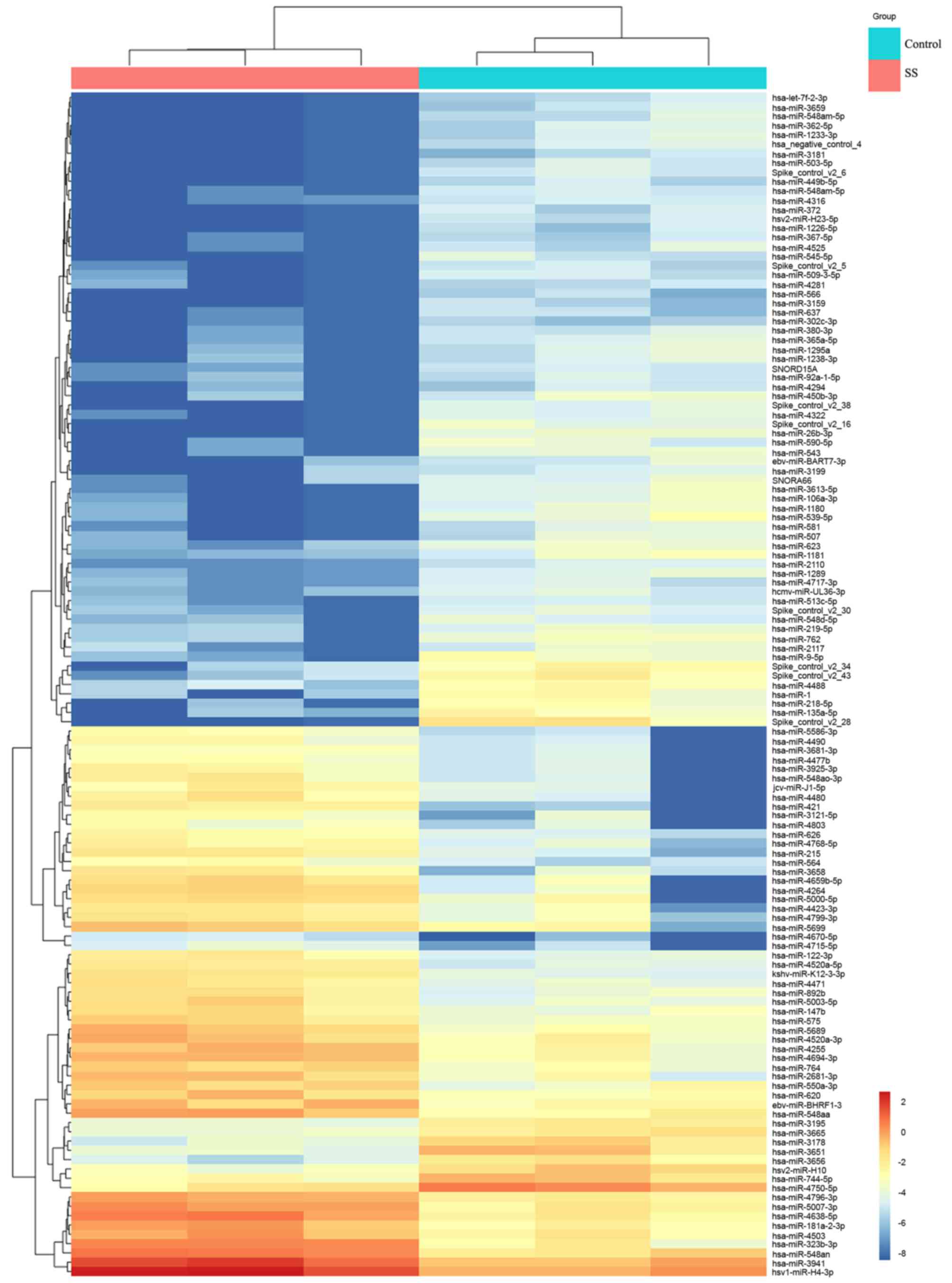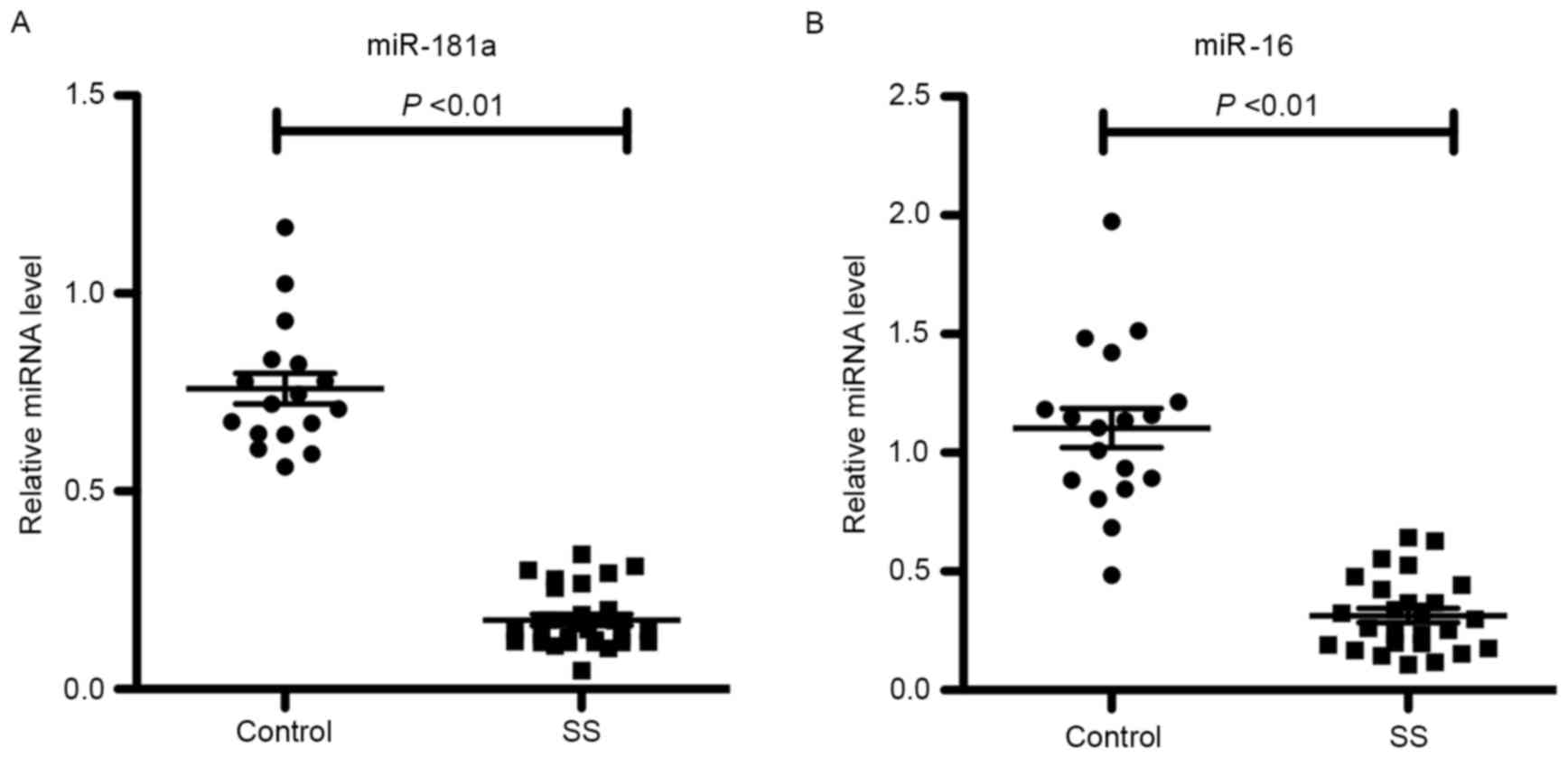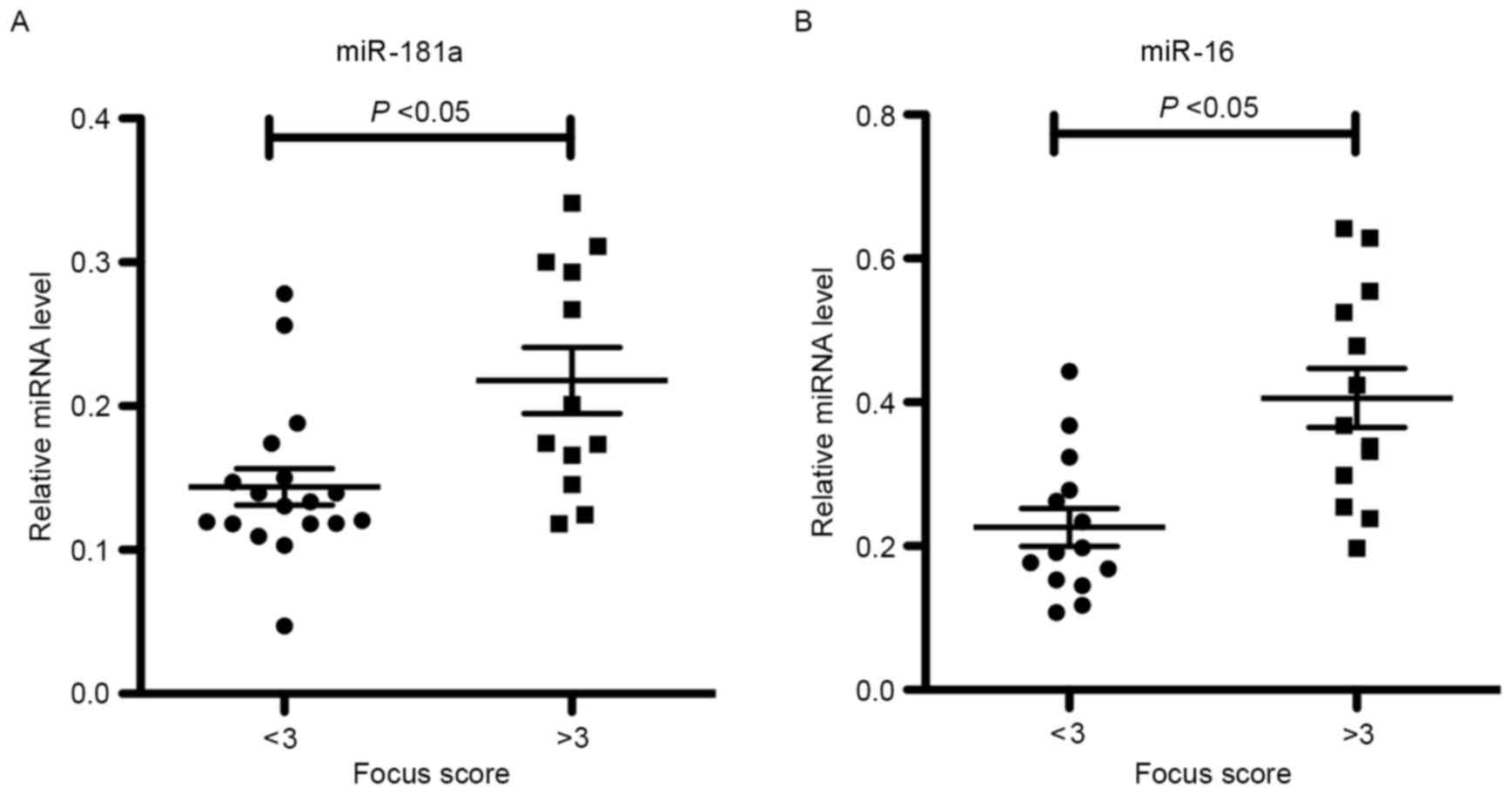|
1
|
Tincani A, Andreoli L, Cavazzana I, Doria
A, Favero M, Fenini MG, Franceschini F, Lojacono A, Nascimbeni G,
Santoro A, et al: Novel aspects of Sjögren's syndrome in 2012. BMC
Med. 11:932013. View Article : Google Scholar : PubMed/NCBI
|
|
2
|
Cotrim AP and Alevizos I: Human and viral
microRNA expression in Sjögren syndrome. J Rheumatol. 41:2102–2103.
2014. View Article : Google Scholar : PubMed/NCBI
|
|
3
|
Mackay F, Groom JR and Tangye SG: An
important role for B-cell activation factor and B cells in the
pathogenesis of Sjögren's syndrome. Curr Opin Rheumatol.
19:406–413. 2007. View Article : Google Scholar : PubMed/NCBI
|
|
4
|
Greenspan JS, Daniels TE, Talal N and
Sylvester RA: The histopathology of Sjögren's syndrome in labial
salivary gland biopsies. Oral Surg Oral Med Oral Pathol.
37:217–229. 1974. View Article : Google Scholar : PubMed/NCBI
|
|
5
|
Fox PC: Autoimmune diseases and Sjogren's
syndrome: An autoimmune exocrinopathy. Ann N Y Acad Sci.
1098:15–21. 2007. View Article : Google Scholar : PubMed/NCBI
|
|
6
|
Chua JH, Armugam A and Jeyaseelan K:
MicroRNAs: Biogenesis, function and applications. Curr Opin Mol
Ther. 11:189–199. 2009.PubMed/NCBI
|
|
7
|
Bartel DP: MicroRNAs: Genomics,
biogenesis, mechanism, and function. Cell. 116:281–297. 2004.
View Article : Google Scholar : PubMed/NCBI
|
|
8
|
Shi H, Zheng LY, Zhang P and Yu CQ:
miR-146a and miR-155 expression in PBMCs from patients with
Sjögren's syndrome. J Oral Pathol Med. 43:792–797. 2014. View Article : Google Scholar : PubMed/NCBI
|
|
9
|
Carlsen AL, Schetter AJ, Nielsen CT, Lood
C, Knudsen S, Voss A, Harris CC, Hellmark T, Segelmark M, Jacobsen
S, et al: Circulating microRNA expression profiles associated with
systemic lupus erythematosus. Arthritis Rheum. 65:1324–1334. 2013.
View Article : Google Scholar : PubMed/NCBI
|
|
10
|
Tandon M, Gallo A, Jang SI, Illei GG and
Alevizos I: Deep sequencing of short RNAs reveals novel microRNAs
in minor salivary glands of patients with Sjögren's syndrome. Oral
Dis. 18:127–131. 2012. View Article : Google Scholar : PubMed/NCBI
|
|
11
|
Gallo A, Tandon M, Illei G and Alevizos I:
Discovery and validation of novel microRNAs in Sjögren's syndrome
salivary glands. Clin Exp Rheumatol. 32:761–762. 2014.PubMed/NCBI
|
|
12
|
Alevizos I, Alexander S, Turner RJ and
Illei GG: MicroRNA expression profiles as biomarkers of minor
salivary gland inflammation and dysfunction in Sjögren's syndrome.
Arthritis Rheum. 63:535–544. 2011. View Article : Google Scholar : PubMed/NCBI
|
|
13
|
Pauley KM, Stewart CM, Gauna AE, Dupre LC,
Kuklani R, Chan AL, Pauley BA, Reeves WH, Chan EK and Cha S:
Altered miR-146a expression in Sjögren's syndrome and its
functional role in innate immunity. Eur J Immunol. 41:2029–2039.
2011. View Article : Google Scholar : PubMed/NCBI
|
|
14
|
Vitali C, Bombardieri S, Jonsson R,
Moutsopoulos HM, Alexander EL, Carsons SE, Daniels TE, Fox PC, Fox
RI, Kassan SS, et al: Classification criteria for Sjögren's
syndrome: A revised version of the European criteria proposed by
the American-European Consensus Group. Ann Rheum Dis. 61:554–558.
2002. View Article : Google Scholar : PubMed/NCBI
|
|
15
|
Chisholm DM and Mason DK: Labial salivary
gland biopsy in Sjögren's disease. J Clin Pathol. 21:656–660. 1968.
View Article : Google Scholar : PubMed/NCBI
|
|
16
|
Baldini C, Giusti L, Ciregia F, Da Valle
Y, Giacomelli C, Donadio E, Sernissi F, Bazzichi L, Giannaccini G,
Bombardieri S and Lucacchini A: Proteomic analysis of saliva: A
unique tool to distinguish primary Sjögren's syndrome from
secondary Sjögren's syndrome and other sicca syndromes. Arthritis
Res Ther. 13:R1942011. View
Article : Google Scholar : PubMed/NCBI
|
|
17
|
Daniels TE, Cox D, Shiboski CH, Schiødt M,
Wu A, Lanfranchi H, Umehara H, Zhao Y, Challacombe S, Lam MY, et
al: Associations between salivary gland histopathologic diagnoses
and phenotypic features of Sjögren's syndrome among 1,726 registry
participants. Arthritis Rheum. 63:2021–2030. 2011. View Article : Google Scholar : PubMed/NCBI
|
|
18
|
Gourzi VC, Kapsogeorgou EK, Kyriakidis NC
and Tzioufas AG: Study of microRNAs (miRNAs) that are predicted to
target the autoantigens Ro/SSA and La/SSB in primary Sjögren's
Syndrome. Clin Exp Immunol. 182:14–22. 2015. View Article : Google Scholar : PubMed/NCBI
|
|
19
|
Kapsogeorgou EK, Gourzi VC, Manoussakis
MN, Moutsopoulos HM and Tzioufas AG: Cellular microRNAs (miRNAs)
and Sjögren's syndrome: Candidate regulators of autoimmune response
and autoantigen expression. J Autoimmun. 37:129–135. 2011.
View Article : Google Scholar : PubMed/NCBI
|
|
20
|
Livak KJ and Schmittgen TD: Analysis of
relative gene expression data using real-time quantitative PCR and
the 2(-Delta Delta C(T)) method. Methods. 25:402–408. 2001.
View Article : Google Scholar : PubMed/NCBI
|
|
21
|
Chen JQ, Papp G, Szodoray P and Zeher M:
The role of microRNAs in the pathogenesis of autoimmune diseases.
Autoimmun Rev. 15:1171–1180. 2016. View Article : Google Scholar : PubMed/NCBI
|
|
22
|
Brito-Zerón P, Theander E, Baldini C,
Seror R, Retamozo S, Quartuccio L, Bootsma H, Bowman SJ, Dorner T,
Gottenberg JE, et al: Early diagnosis of primary Sjögren's
syndrome: EULAR-SS task force clinical recommendations. Expert Rev
Clin Immunol. 12:137–156. 2016. View Article : Google Scholar : PubMed/NCBI
|
|
23
|
Shiboski SC, Shiboski CH, Criswell L, Baer
A, Challacombe S, Lanfranchi H, Schiødt M, Umehara H, Vivino F,
Zhao Y, et al: American College of Rheumatology classification
criteria for Sjögren's syndrome: A data-driven, expert consensus
approach in the Sjögren's International Collaborative Clinical
Alliance cohort. Arthritis Care Res (Hoboken). 64:475–487. 2012.
View Article : Google Scholar : PubMed/NCBI
|
|
24
|
Bi C and Chng WJ: MicroRNA: Important
player in the pathobiology of multiple myeloma. BioMed Res Int.
2014:5215862014. View Article : Google Scholar : PubMed/NCBI
|
|
25
|
Chen CZ, Li L, Lodish HF and Bartel DP:
MicroRNAs modulate hematopoietic lineage differentiation. Science.
303:83–86. 2004. View Article : Google Scholar : PubMed/NCBI
|
|
26
|
Henao-Mejia J, Williams A, Goff LA, Staron
M, Licona-Limón P, Kaech SM, Nakayama M, Rinn JL and Flavell RA:
The microRNA miR-181 is a critical cellular metabolic rheostat
essential for NKT cell ontogenesis and lymphocyte development and
homeostasis. Immunity. 38:984–997. 2013. View Article : Google Scholar : PubMed/NCBI
|
|
27
|
Peng L, Ma W, Yi F, Yang YJ, Lin W, Chen
H, Zhang X, Zhang LH, Zhang F and Du Q: MicroRNA profiling in
Chinese patients with primary Sjögren syndrome reveals elevated
miRNA-181a in peripheral blood mononuclear cells. J Rheumatol.
41:2208–2213. 2014. View Article : Google Scholar : PubMed/NCBI
|
|
28
|
Alevizos I and Illei GG: MicroRNAs in
Sjögren's syndrome as a prototypic autoimmune disease. Autoimmun
Rev. 9:618–621. 2010. View Article : Google Scholar : PubMed/NCBI
|
|
29
|
Li QJ, Chau J, Ebert PJ, Sylvester G, Min
H, Liu G, Braich R, Manoharan M, Soutschek J, Skare P, et al:
miR-181a is an intrinsic modulator of T cell sensitivity and
selection. Cell. 129:147–161. 2007. View Article : Google Scholar : PubMed/NCBI
|
|
30
|
Aqeilan RI, Calin GA and Croce CM: miR-15a
and miR-16-1 in cancer: Discovery, function and future
perspectives. Cell Death Differ. 17:215–220. 2010. View Article : Google Scholar : PubMed/NCBI
|
|
31
|
Tung YT, Huang PW, Chou YC, Lai CW, Wang
HP, Ho HC, Yen CC, Tu CY, Tsai TC, Yeh DC, et al: Lung
tumorigenesis induced by human vascular endothelial growth factor
(hVEGF)-A165 overexpression in transgenic mice and amelioration of
tumor formation by miR-16. Oncotarget. 6:10222–10238. 2015.
View Article : Google Scholar : PubMed/NCBI
|
|
32
|
Cui J: MiR-16 family as potential
diagnostic biomarkers for cancer: A systematic review and
meta-analysis. Int J Clin Exp Med. 8:1703–1714. 2015.PubMed/NCBI
|
|
33
|
Pauley KM, Satoh M, Chan AL, Bubb MR,
Reeves WH and Chan EK: Upregulated miR-146a expression in
peripheral blood mononuclear cells from rheumatoid arthritis
patients. Arthritis Res Ther. 10:R1012008. View Article : Google Scholar : PubMed/NCBI
|
|
34
|
Filková M, Aradi B, Senolt L, Ospelt C,
Vettori S, Mann H, Filer A, Raza K, Buckley CD, Snow M, et al:
Association of circulating miR-223 and miR-16 with disease activity
in patients with early rheumatoid arthritis. Ann Rheum Dis.
73:1898–1904. 2014. View Article : Google Scholar : PubMed/NCBI
|













